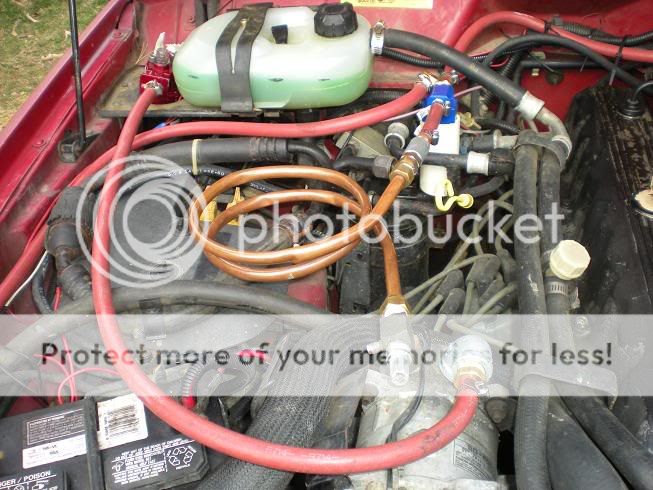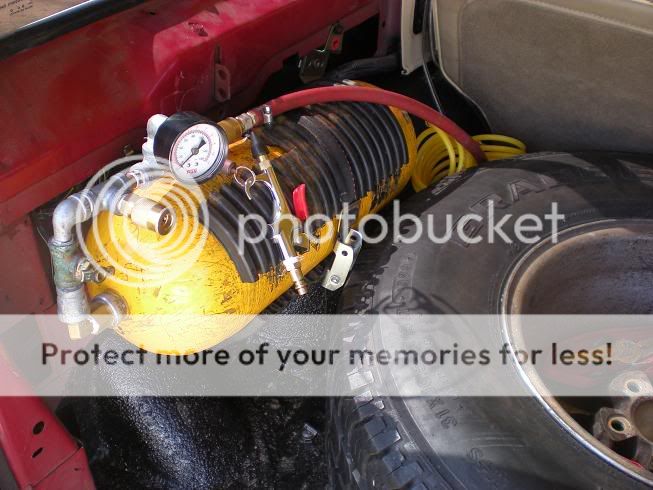-
Welcome to the new NAXJA Forum! If your password does not work, please use "Forgot your password?" link on the log-in page. Please feel free to reach out to [email protected] if we can provide any assistance.
- Home
- Forums
- NAXJA Unibody Jeep Technical Forums
- Jeep Cherokee XJ (1984 - 2001)
- Modified Tech Discussion
You are using an out of date browser. It may not display this or other websites correctly.
You should upgrade or use an alternative browser.
You should upgrade or use an alternative browser.
Finished CO2 mount
- Thread starter SnagglePuss
- Start date
- Location
- Houston, Tx
Do you have issues with the bottle mounted sideways?
Markos
NAXJA Forum User
- Location
- Seattle, WA
Do you have issues with the bottle mounted sideways?
All signs point to that being an O2 tank, with all of the tubing and your simple air-compressor style check valve (with the key ring). I suppose you could mount the tank sideways and use it if the liquid CO2 wasn't resting against the valve. If that is a CO2 tank, it's plain scary IMO. In a normal setup, the high pressure CO2 is contained in a tank. The first fitting is the valve. In this setup, there is a bunch of threaded tubing before the valve, which probably isn't rated for 3000 psi. Speaking of which, I do not see a burst disk anywhere. That must be an O2 tank, but where is the input hose from the compressor?
I keep my tank strapped to the floor on it's side. I never keep the tank in the vehicle when not offroading, and I remove the tank from the jeep and hold it upright when filling my tires. This works fine and keeps it from rolling around. Although, I've received a very informative warning from a fellow poster on colorado4x4.org
Originally posted by Mudbug63:
Markos I'm not raggin on you here just relaying my reasoning.
Let me also say I carry a Co2 tank so this is not meant to say they are bad just informing the masses of the gotchas.
I worked for years in a welding supply house and trust me you don't want to be around a Co2 tank if its laying on its side and the safety on the valve pops, you get a stream of liquid Co2 instead of gas. You are begging for instant frostbite not to mention you have a near instant snow and fog storm in your jeep. Think of a Co2 Fire extinguisher set off in the back of your jeep with no way to shut it off.
Most people think that safeties only pop when the tank is over pressurized and that is their true purpose. However I think we can all agree that there is metal fatigue and a safety bursting disc is made of very very thin metal. Combine this with the fact that Co2 has one of the widest pressure swings in relation to temperature of any gas you have the makings of a popped disc over time. In other words the pressure rises quickly as the temperature rises and the reverse is also true.
On a typical Colorado day it would not be uncommon for a tank in a enclosed jeep to vary several hundred pounds in pressure from morning to night. Over time this creates fatigue on the safety disc and can lead failure at a lower then designed pressure without warning. We routinely had safeties pop while the filled tanks were sitting in stock out on a open dock from just this reason. Age of the safety disc obviously has a roll in this since the fatigue is cumulative. You are probably at more risk if you use a tank that is swapped out for another one every time its empty and you have no idea of its history then if you own your tank. I would insist the disc be replaced every time the tank is hydrotested.
Another hazard that no one ever seems to mention is suffocation if this happens in a enclosed space. This is true regardless of the mounting position but if its dumping liquid the process is a lot quicker.
A 20# tank equals about 2.3 gallons of Co2 which makes about 170 cubic feet of gas at 70 degrees F. It does not take long to dump a 20# tank when the safety pops...I mean thats its job to dump the pressure. Also keep in mind it does not have to displace all of the oxygen just enough to lower the level to a point you pass out. I am not sure of the cabin size on a TJ but I am willing to bet it is less then 80 cubic foot so a 20# tank would displace the contents of the cab twice.
Granted this is not a big deal if you are just tooling down the trail and you can open the door but if you are in a rollover and knocked out or trapped and cant open a door you stand a good chance of sleeping for a very very long time in a nice metal box under a well maintained lawn.
Will anything happen if you mount it on its side probably not but I am not willing to risk it to save $30 bucks on a proper mount. I mount my tank in a DOT rated fire extinguisher bracket in a upright position and drive with doors off or the windows down regardless of weather. Maybe I'm paranoid but I think I am just being cautious because I have seen one of these blow a safety first hand.
ETA: I also only carry the tank when on the trail not in everyday driving.
BruceB83
NAXJA Forum User
- Location
- Dacula, Georgia
Thanks, that's pretty good. Cheapest I found was on ebay for $78 + shipping. It was a nice 10# aluminum one though.
Wow...link please! The cheapest I've found was $118 for a 10# aluminum CO2 tank.
Edit...found it...it helps to put "10" and not "1" when looking for a 10 lb. tank...:sad1:
Last edited:
4wdParakeet
NAXJA Forum User
- Location
- Olathe, Ks
I'm looking for the fixed reg. for 49 bucks. I can't find one for less than 55 bucks.
Parakeet
Parakeet
Bolt it to the rim on your spare tire through the lug holes.
=========================================
Great idea, I'm going with it. May need to beef up the tire mount a bit but that's cool.
ThanksI
trust me you don't want to be around a Co2 tank if its laying on its side and the safety on the valve pops, you get a stream of liquid Co2 instead of gas.
===============================================================
True: Vent the safty outside.
It's not recommended. but can be done safely.
=======================================
Also you tank can be used on it's side if a small expansion tank is mounted well above the main storage tank and before the regulator or anything else that don't like liquid Co2
Don't forget the EX tank Has to be above M tank even when on steep grades!!!!!!!!
=========================================
Great idea, I'm going with it. May need to beef up the tire mount a bit but that's cool.
ThanksI
trust me you don't want to be around a Co2 tank if its laying on its side and the safety on the valve pops, you get a stream of liquid Co2 instead of gas.
===============================================================
True: Vent the safty outside.
It's not recommended. but can be done safely.
=======================================
Also you tank can be used on it's side if a small expansion tank is mounted well above the main storage tank and before the regulator or anything else that don't like liquid Co2
Don't forget the EX tank Has to be above M tank even when on steep grades!!!!!!!!
Last edited:
Markos
NAXJA Forum User
- Location
- Seattle, WA
The yellow tank looks more like a regular air tank, possibly a Scott or something similar, from the fire service where it may have used as an SCBA.
Yeah it is. Ritter just confused the issue by posting a picture of his O2 OBA setup. The hose in the first picture is the input. The output hose connects to the chuck by the pressure guage.
Here's the other half of his setup:

Similar threads
- Replies
- 0
- Views
- 603
- Replies
- 2
- Views
- 1K

